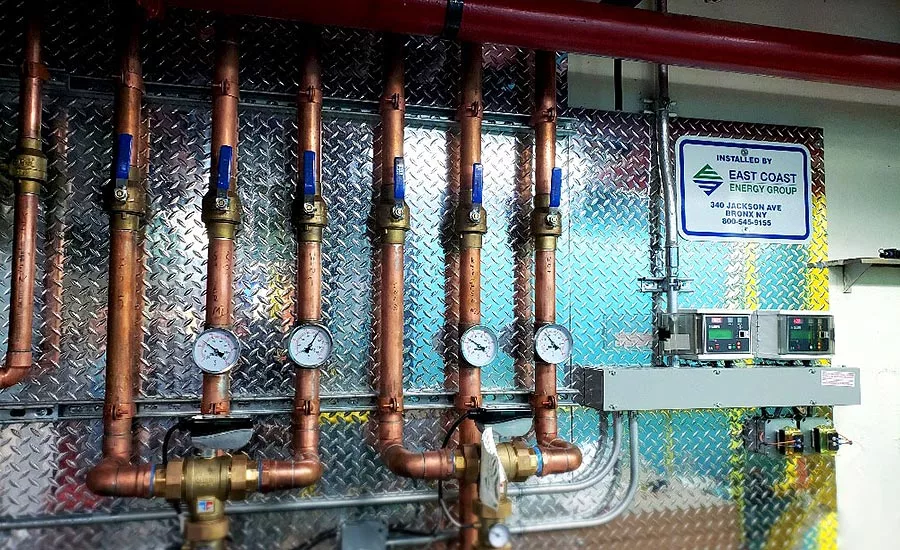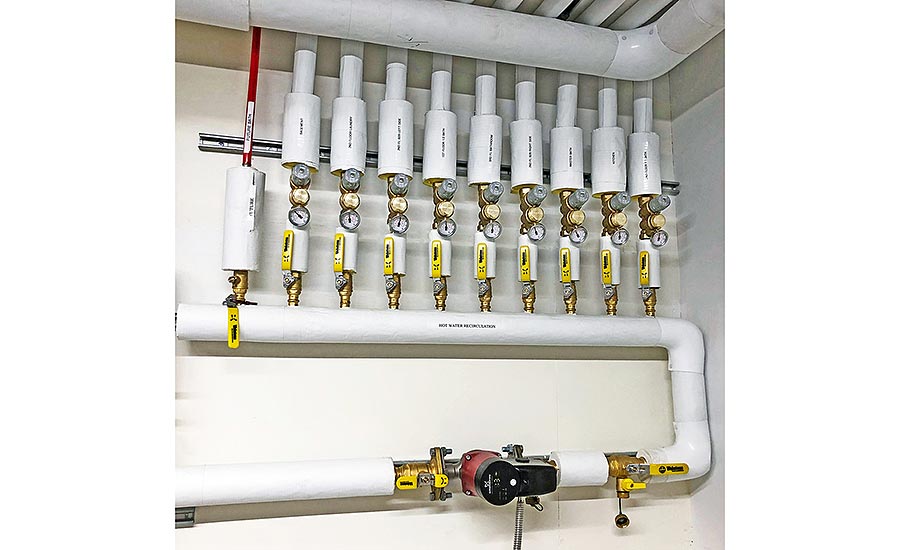Water safety in DHW recirculation
5 things you need you know.

East Coast Energy Group completed this installation featuring Caleffi’s LEGIOMIX electronic mixing valve, which features optional programs for thermal disinfection of hot water recirculation systems to kill Legionella bacteria.
Domestic hot water recirculation system design is a hot topic in our industry, for good reason. It is vital to ensuring water safety and occupant comfort in complete commercial plumbing systems.
We all benefit from recent trade articles, webinars and chat forums that exchange views about the best practices of DHW circuit design relating to recirculation temperatures, proper circulator sizing, installation tips and more. I applaud the knowledge-sharing that further educates our fellow plumbing professionals. In that spirit, let’s focus on the following five things you need to know about ensuring water safety in DHW recirculation systems.
5 design principles
1. Keep the hot, hot. Maintain recirculation loop temperature above 122° F at all locations, and at all times.
Water safety refers to the delicate balance of maintaining a high enough recirculation temperature to prevent Legionella growth while also assuring safe water temperatures at all fixtures and points of use. A safe and sanitary DHW system must be designed and installed with this balance as a priority.

Figure 1 illustrates the temperature/time relationship between water temperature and control of Legionella bacteria. Any section of plumbing piping that contains water below 122°, especially if that water is stagnant and old, offers an ideal environment for Legionella bacteria to grow and multiply to dangerous concentrations. Legionella can survive above 122°, but do not multiply. Make note that 122° is based on ideal conditions; if the piping is corroded and has significant biofilm (perfect cover and habitat for bacteria) then a higher temperature is needed to keep the bacteria in check.
To reduce the risk of scalding, why not design the system so that the DHW supply set point is below 122°? It’s because the potential for Legionella issues makes it too risky. There is a better way.
2. Provide anti-scald devices at all points of use. It’s worth the added cost!
There is a simple way to provide sanitary AND safe DHW at the same time. Yes, it will cost more to provide anti-scald devices at all points of use (as shown in Figure 2), but it’s the right approach.

In a recirculation system that includes point-of-use anti-scald valves throughout, the recirculation water can be maintained at higher temperatures, which will control Legionella, without compromising safety at the points of use.
ASSE 1070 compliant thermostatic mixing valves mix the higher temperature recirculation loop water with cold water to deliver safe, tempered water to the fixture “hot” inlet. The valves have a maximum set point adjustment of 120°, and can be set even lower, for example 115° or 110°, to meet specific building requirements and even individual room-to-room needs.
Maintaining safe temperatures at all points of use is critical. Figure 3 illustrates the danger of scalding at various temperatures and exposure times. It is generally understood that 120° is a maximum safe temperature, however, facilities that cater to occupants that cannot react quickly to hot water may require lower “hot” temperatures, such as 105°, which is safe for everyone.

3. Keep it moving. Don’t turn off that circulator!
Some project specifications call for a means to turn off recirculation flow during periods of low/no demand, typically using an aquastat or a time clock, in an effort to save energy. On this topic, there are conflicting guidelines in our industry. For example, the 2012 Uniform Plumbing Code calls for it to save energy, while OSHA condemns it in favor of preventing stagnation to reduce the risk of Legionella growth. With today’s highly-efficient circulators, saving a few watt-hours by turning off the circulator is not worth the risk associated with allowing the warm water to stagnate. Disease prevention trumps energy savings. Of course, as always, the local authority having jurisdiction makes the final call.
4. Secondary circuit balancing must be done — and must be done right.
I encounter many DHW recirculation systems that, while being otherwise well designed, ultimately run into trouble due to improper balancing. Occupant complaints about long wait times for hot water and balancing valves simply left fully open are all too common. Whether using manual, automatic or the relatively new thermal balancing valves (my personal favorite), proper balancing will assure all secondary circuits have sufficient flow to provide hot water for all the fixtures in that circuit. Proper balancing is like icing on the cake for a plumbing project.
Figure 4 is a simplified schematic showing thermal balancing valves properly located in the return pipe of each secondary circuit before they join up with the return trunk and the circulator. The thermal balancing valves are set to 130°, the DHW supply set point is 140°, and the final return design temperature is 120° F (I know, I said 122° earlier, but as stated, this is a simplified schematic).
This concept works very well; thermal balancing valves are a temperature solution for a temperature problem, and they make balancing as simple as turning a knob. Notice the anti-scald valves at each point of use in the schematic (the lavs have 4-port under-sink anti-scald ASSE 1070 valves and the shower valves are ASSE 1016).

The photo in Figure 5 shows a great example of thermal balancing valves in a DHW system. Notice how each valve is located in the circuit return pipe before they combine into the trunk where the recirculation pump is located, matching the schematic in Figure 4.

5. Eliminate the potential for recirculation temperature creep. The point-of-distribution “master mixing” valve is key.
Recirculation temperature creep is the condition whereby recirculation water temperature can reach as high as the temperature in the tank. It can take place during periods of no demand, when the recirculation loop is devoid of fresh, cold water because none is being consumed at the faucets. It’s a matter of balancing the heat added by the heat source and the small amount of heat loss from the recirculating water to ambient.
In short, if the master mixer does not have the ability to close its hot inlet port 100%, small manual balancing valves must be installed in the recirculation return lines to balance out the heat added/lost and thus prevent creep. If the mixing valve can close tight to the hot, those balancing valves are unnecessary.
Plumbing professionals across the industry — from on-call service contractors and designers to new product innovators in manufacturing — have never been as important and influential as we are today in maximizing comfort and safety related to today’s domestic water systems and protecting the public from waterborne diseases. Following the design principles of the five things you need to know which we discussed above will help ensure total water safety in domestic water recirculation systems.
Looking for a reprint of this article?
From high-res PDFs to custom plaques, order your copy today!






